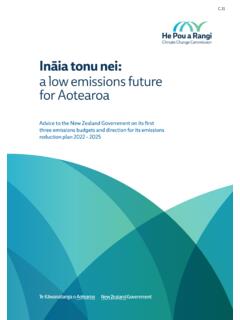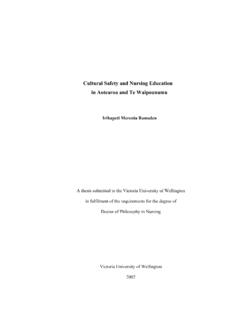Transcription of YOUTH MENTAL HEALTH IN AOTEAROA NEW ZEALAND: …
1 Koi T . Commentary YOUTH MENTAL . HEALTH IN AOTEAROA . NEW zealand : GREATER URGENCY. REQUIRED. Rochelle Menzies, Sir Peter Gluckman, Richie Poulton September 2020. KEY INSIGHTS. There is a silent pandemic of MENTAL morbidity amongst the global YOUTH population which will have adverse lifecourse consequences The last decade has seen a rapid and concerning rise in YOUTH psychological distress and suicide rates Nationally, poor MENTAL HEALTH for YOUTH is persistently inequitable and worsening Impacts of COVID-19 on YOUTH MENTAL HEALTH is likely to be extensive and enduring Protection and promotion of MENTAL wellbeing for YOUTH is now a matter of urgency A GROWING MENTAL HEALTH PANDEMIC. Global statistics about YOUTH MENTAL HEALTH and suicide over the last decade reveal a disturbing trend. They showed a marked increase in psychological distress for this age group, perhaps reflecting the rapidly increasing magnitude of the challenges faced by young people currently.
2 As the pandemic of psychological distress among YOUTH rises at an alarming rate, the underlying causes and the need for prevention and intervention remains largely ignored. There is a seemingly unappreciated urgency around this issue, which is now largely lost amidst the global COVID-19 crisis, although the pandemic almost certainly exacerbates the issues. This glaring oversight must be acknowledged, understood and addressed. Continued failure to do so will ultimately result in significant harms to the overall wellbeing and economic prosperity of many nations, including AOTEAROA New zealand . Worldwide, the rapid rise in MENTAL morbidity and frequency of psychological distress among young people indicates their right to optimal MENTAL HEALTH and wellbeing is not realised. This is not conducive to societal resilience, which relies to an extent on individuals being resilient to rapid change.
3 The World HEALTH Organization (WHO) notes that the promotion and protection of MENTAL HEALTH can improve quality of life, strengthen human capital, contribute to socioeconomic development and lead to a more equitable world .1 There is enormous unmet need and this leads to a deeper question what is the basis for this very rapid rise in morbidity that is being seen in so many countries? The WHO reports that 16% of the global burden of disease and injury for adolescents aged 10-19 years is attributable to MENTAL morbidity, such as depression and anxiety. They estimate that 10-20% of adolescents worldwide will experience MENTAL illness to some extent a disturbing percentage and one that is likely to be Further, a large portion of the billion global YOUTH population have symptoms that compromise their MENTAL wellbeing, which when combined with the normal risk taking of adolescence increases their risks of injuries, self-harm and substance abuse.
4 For YOUTH belonging to disadvantaged populations and marginalised communities, the risks of MENTAL illness, addictions and suicide are much higher. Ethnicity, poverty and sexual orientation are particularly critical determinants of MENTAL HEALTH and 1 WHO. 2019. Adolescent MENTAL HEALTH : Time for Action. Available from 2 Moffitt, T. E., Caspi, A., Taylor, A., Kokaua, J., Milne, B. J., Polanczyk, G., & Poulton, R. 2010. How common are common MENTAL disorders? Evidence that lifetime prevalence rates are doubled by prospective versus retrospective Medicine, 40(6), 899 909. 3 WHO. 2019. Adolescent MENTAL HEALTH : Time for Action. Available from YOUTH MENTAL HEALTH and wellbeing in AOTEAROA New zealand 2. RISING RATES OF YOUTH DEPRESSION. Unfortunately, the situation in AOTEAROA New zealand is particularly concerning, with MENTAL morbidity rates more than doubling over the last two decades, for both males and females.
5 More specifically, the national prevalence of MENTAL HEALTH morbidity (using somewhat stricter criteria than those used in many studies in 2011/12) was 5%, rising to in 2018 The national teenage (15-19 years) suicide rates are among the highest in the OECD5 and 2013 findings from the Youth12 survey of secondary school students reported 24% of all respondents had intentionally self-harmed in the preceding 12 The Youth2000 project has undertaken repeated cross-sectional studies to produce snapshots of YOUTH Data for 2001, 2007, 2012 and 2019 surveys show persistent concerning and rising self- reported rates for depression and Preliminary findings from the Youth19 survey (2019 wave of the series) of 7,721 school students (year 9-13). aged 13-19 years, paint an especially bleak picture of YOUTH MENTAL HEALTH and wellbeing, with only 69%.
6 Reporting good emotional Of the total cohort, 23% (29% of females and 17% of males) report having symptoms of depression, which is almost twice the rate found in 2012 (17% and 9%respectively). Similarly, 6% of the 2019 cohort ( of females and 5% of males) report they attempted suicide in the previous 12 months, which for males is twice the rate ( ) reported in 2012. These gender differences and rates are compatible with overseas data. For example, repeated standardised MENTAL HEALTH surveys in Denmark show a 50% increase in MENTAL HEALTH morbidity between 2010 and 2017, to 24% in 16-25 year old females and to 13% in GENDER AND ETHNIC INEQUITIES. The gender inequities in YOUTH MENTAL HEALTH highlighted in the Youth19 findings are not new. Between 2000. and 2019, the cross-sectional Youth2000 findings reveal female youths consistently have rates of depression symptomatology and suicidality that are almost double the rates reported by their male Within ethnic minority groups this inequitable trend holds true for M ori and Pasifika females, over this time period.
7 However, the 2019 survey findings show the gender inequity in depression has increased among Pasifika YOUTH with a sharp increase in female rates to 37% compared to 15% for males. Moreover, the Youth19 findings also provide strong evidence of a social gradient in YOUTH MENTAL HEALTH ,12. with YOUTH from high deprivation areas having higher rates (30%) of self-reported depression symptoms than those from medium (23%) and low (17%) deprivation areas. Likewise, a social gradient is apparent with regards to attempted suicide, with rates doubling between each deprivation classification: low ( ), medium (6%) and high (11%). In addition to these socioeconomic inequities, there is evidence from the Youth19 survey of ethnic inequities in YOUTH MENTAL For example, rangatahi M ori have higher reported rates for symptoms of depression than their P keh counterparts.
8 Specifically, findings for female youths reporting depression symptoms revealed significant inequity, with 38% for M ori and 24% for P keh YOUTH . Depression rates for male YOUTH were found to be 19% for M ori compared to 15% for P keh . Similarly, findings for Pasifika YOUTH show significant ethnic inequity with 37% of Pasifika females reporting symptoms of depression compared to 24% of Palangi females. 4 Ministry of HEALTH . 2020. New zealand HEALTH Survey Online. Available from: new- zealand - HEALTH -survey 5 OECD. 2017. Teenage suicides (15-19 years old). See 6 Adolescent HEALTH Research Group. 2013. The HEALTH and Wellbeing of New zealand Secondary School Students in 2012: YOUTH '12 Prevalence Tables (p 97). The University of Auckland. Available at 7 The Adolescent HEALTH Research Group - Youth2000 Survey Series, Faculty of Medical & HEALTH Sciences, The University of Auckland.
9 See 8 Clark, T., Fleming, T., Peiris-John, R., Sutcliffe, K. 2020. Youth19 Rangatahi Smart Survey National Launch Webinar (13 Aug). Available at: publications/2020/8/24/youth19-rangatahi -smart-survey-webinar-initial-findings 9 ibid 10 National Board of HEALTH . 2018. Dane's HEALTH The National HEALTH Profile 2017. Copenhagen, Denmark: National Board of HEALTH (Denmark). 11 Clark, T., Fleming, T., Peiris-John, R., Sutcliffe, K. 2020. Youth19 Rangatahi Smart Survey National Launch Webinar (13 Aug). Available at: publications/2020/8/24/youth19-rangatahi -smart-survey-webinar-initial-findings 12 ibid 13 ibid YOUTH MENTAL HEALTH and wellbeing in AOTEAROA New zealand 3. A particular concern are the Youth19 survey's MENTAL HEALTH and wellbeing findings related to the gender identity and sexual orientation of YOUTH .
10 Among the Rainbow (T&LGBTQA) young persons surveyed, a staggering 57% reported experiencing symptoms of DETERMINANTS OF YOUTH MENTAL HEALTH . The question arises: why have these rates risen so quickly? What are the features of contemporary adolescence that have fueled this MENTAL HEALTH pandemic? In seeking answers we should examine both proximal issues such as the digital milieu, and more removed issues such as early life experience, trauma, educational structures, and changing parenting, family and social The most important issues for YOUTH , as identified by respondents in the Youth19 survey, included (1) social media and technology, (2) bleak futures and climate change, (3) pressure and (4) risky Interestingly, these findings are supported by international literature investigating the MENTAL HEALTH of young persons aged 10-24 Although the biological and developmental determinants of poor MENTAL HEALTH and increased suicide risk have been well-researched, there is need to focus on what underlies this rapid deterioration and increasing prevalence.








